HAVCR1 is connected to sickness vulnerability and was first detected in primate kidney cells. HAVCR1 has been found as a biomarker for hepatitis and acute renal injury that is both sensitive and specific. According to Vila et al., HAVCR1 inhibited cell differentiation and was highly expressed in clear cell renal cell carcinoma. According to current research, HAVCR1 has been associated with a variety of aggressive cancers, including renal cell carcinoma, human colorectal cancer, and ovarian clear cell carcinoma. As a result, HAVCR1 can be employed as a biomarker for the development and progression of tumors.
To produce the recombinant HAVCR1 antibody genes were cloned from B cells that were isolated from immunized animals with the A synthesized peptide derived from human TIM 1 and then were inserted into plasma vectors. Mammalian cells like CHO and HEK 293 cells were transfected with these recombinant vectors allowing for antibody expression. The cell culture supernatant underwent purification via Affinity-chromatography to obtain the recombinant HAVCR1 antibody. This recombinant HAVCR1 antibody can react with the HAVCR1 protein from Human, Mouse and is recommended for the use in the ELISA, WB.




